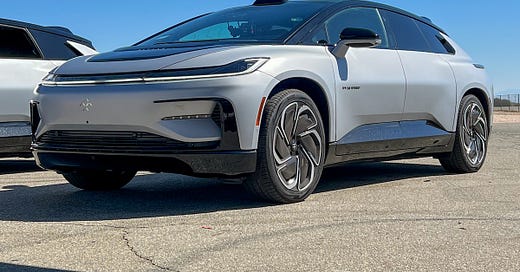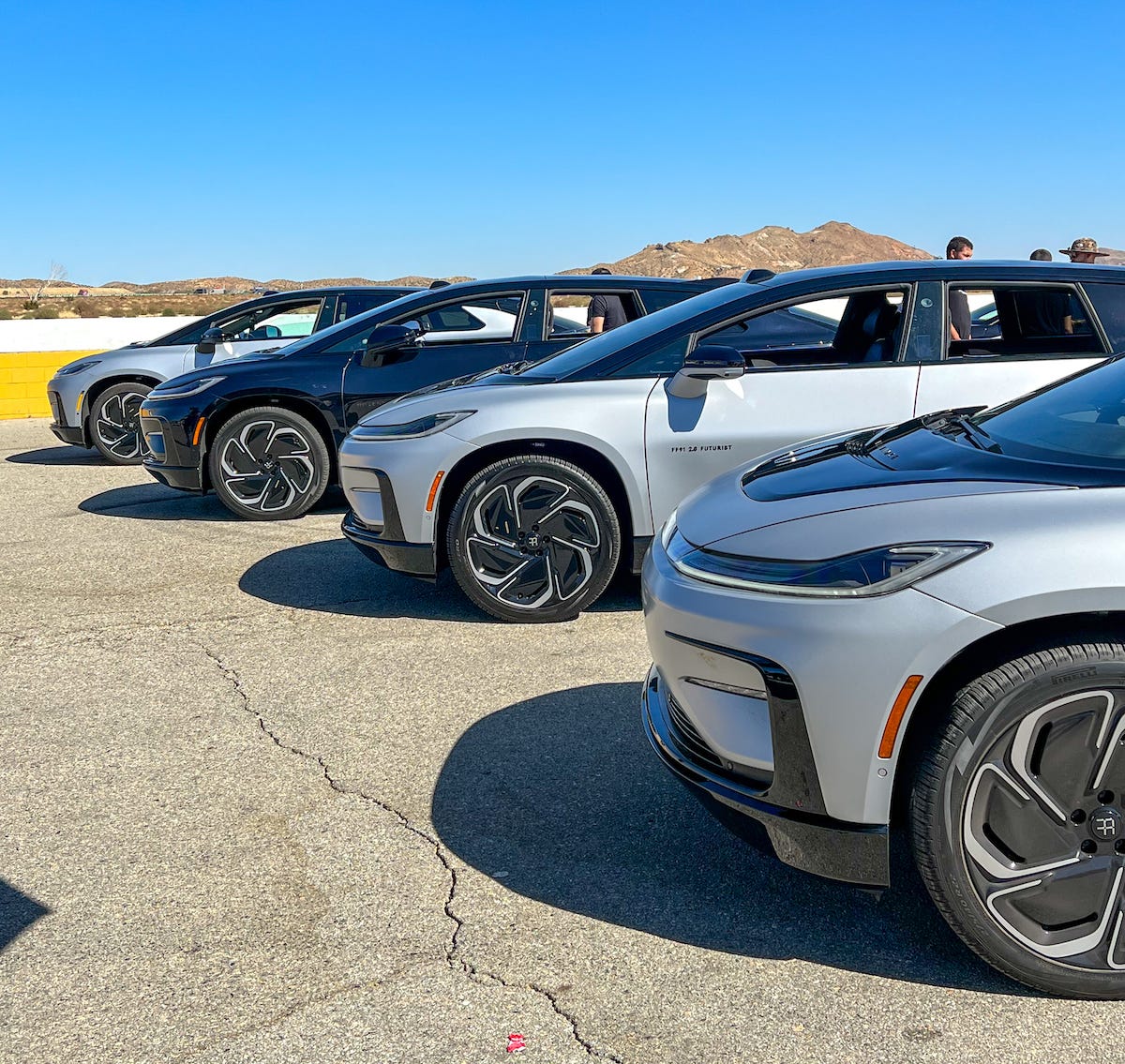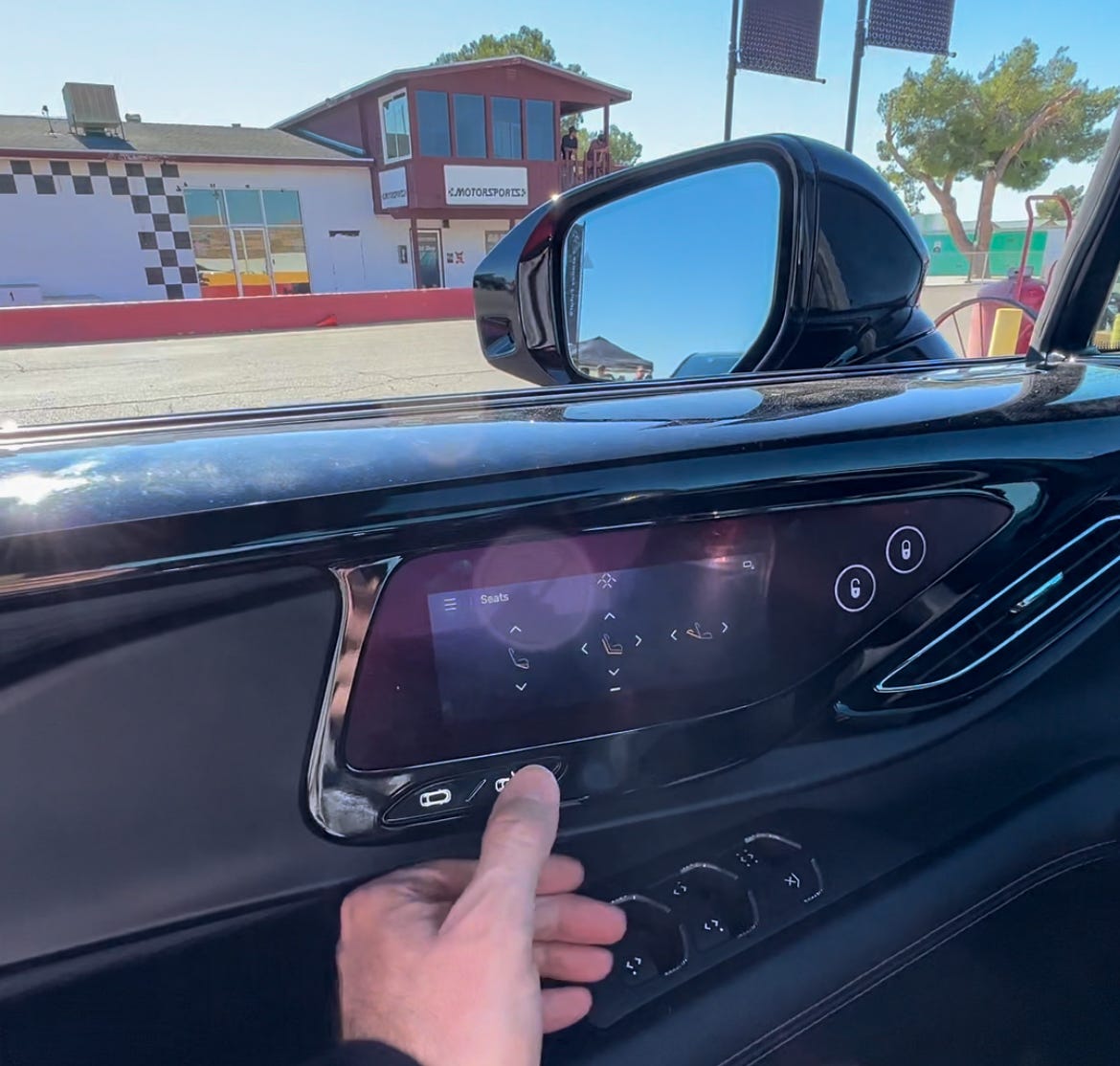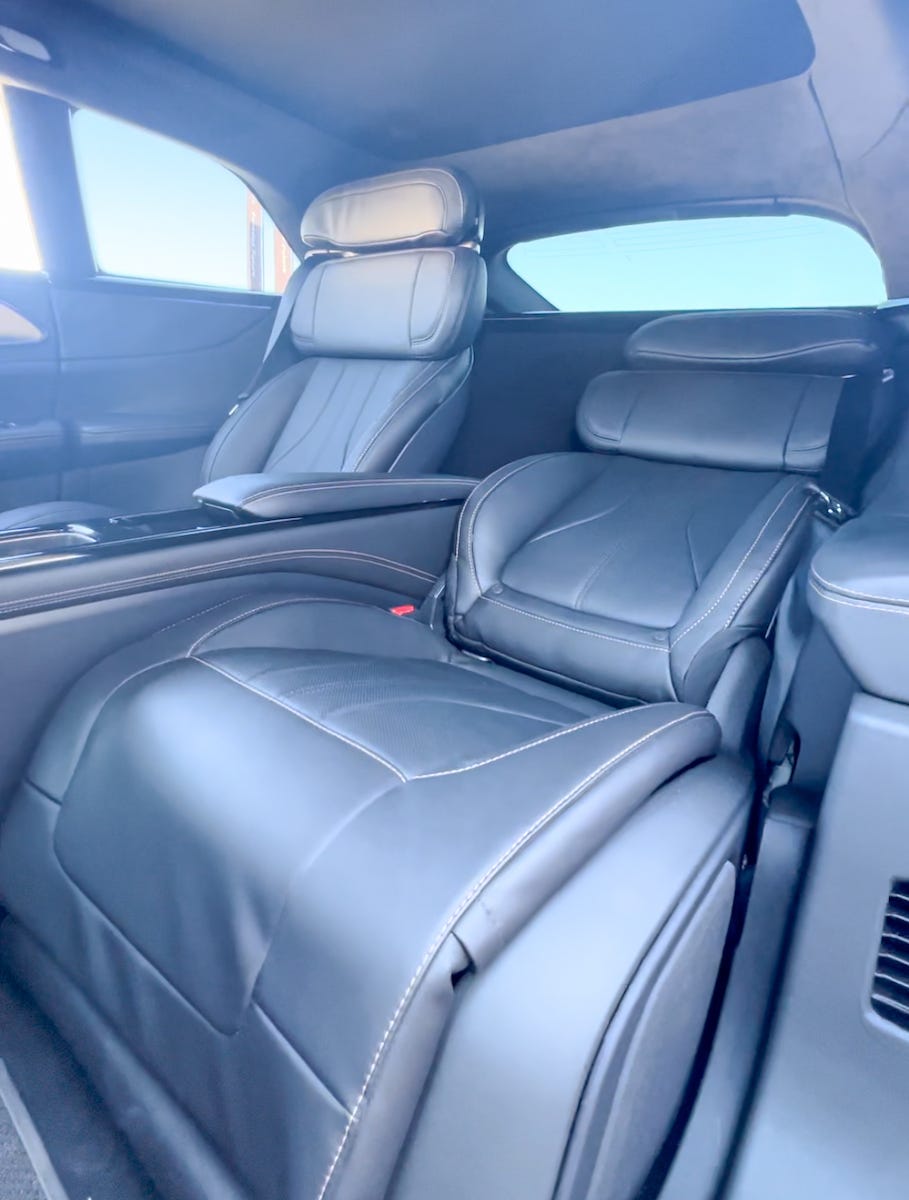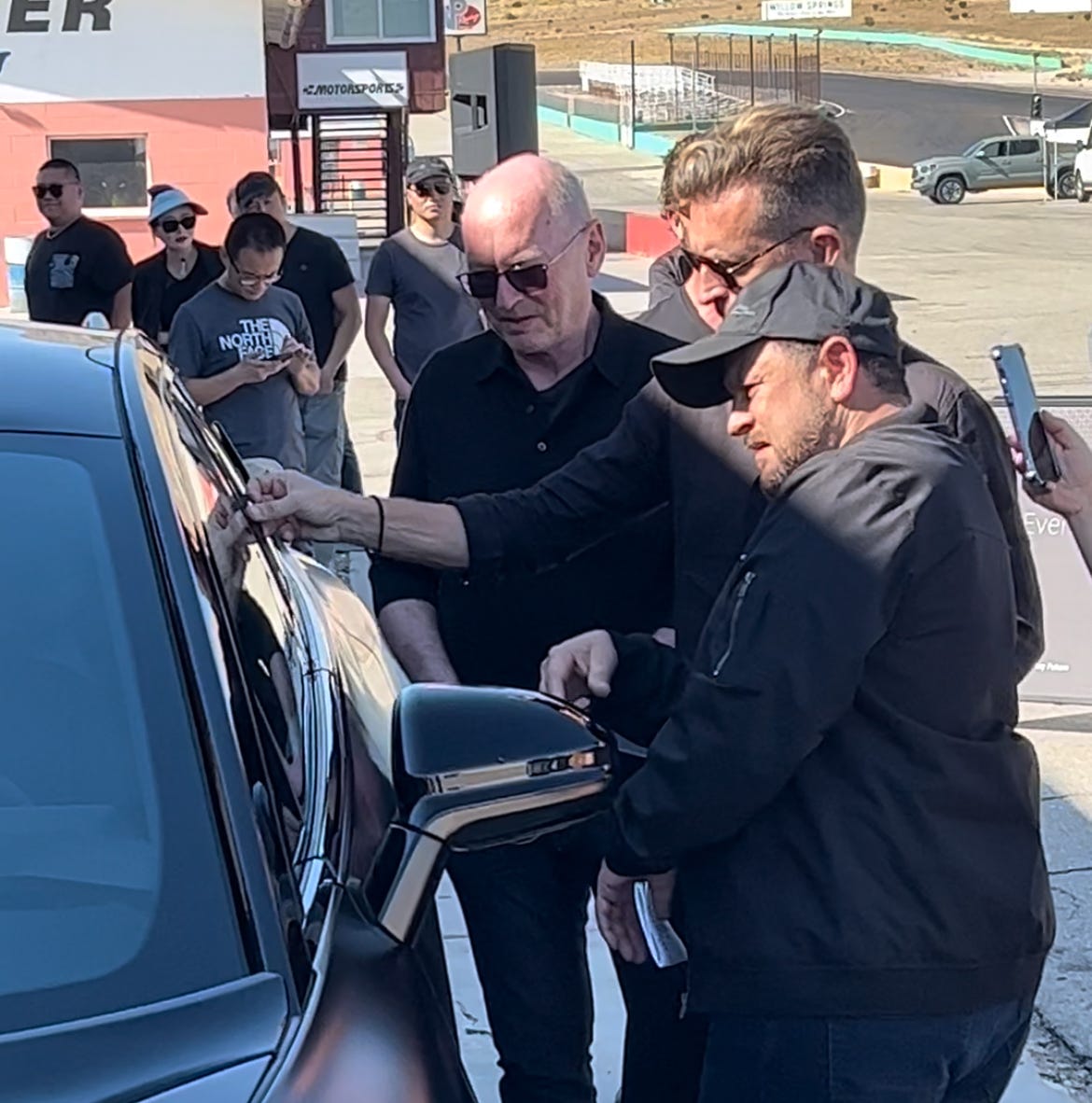FARADAY FUTURE IS FINALLY delivering its $300,000 electric vehicle to customers.
For almost any other car company, that would be the whole story. But with Faraday Future, there’s always more. The startup was supposed to deliver its car, the FF 91, years ago. Then Faraday appeared on the brink of bankruptcy, it laid off a ton of staff, and the stock price plummeted. It felt like the end.
But miraculously, the company survived. Somehow. And now they’re back — actually building cars and giving them to paying customers. Comeback stories like this are extremely rare, and extremely hard to believe for journalists like me who have seen EV brands like Byton, Aptera and Lordstown come and go.
I might not have believed it. Except I showed up to Willow Springs Raceway a couple of weeks ago on an invite from a friend. And the place was crawling with Faradays.
This immediately struck me as weird. I thought I was pulling up to a small car culture meet. Instead I found myself in the center of a big-budget automaker launch with only two other journalists in attendance.
“Do you want to participate in the media drive?” I was asked.
“There’s a media drive?” I answered.
Of course the answer was yes, I wanted to drive it. Almost no one has driven a working Faraday FF 91 yet. Frankly, I was flabbergasted at the luck I’d walked backwards into.
First there was pomp and circumstance to witness. Faraday used the day to show off the performance chops of its new toy. They rented out the track and hired professional drivers to set lap records in some fully-prepped FF 91 prototypes. I stood next to company execs and prospective customers — covered head-to-toe in Gucci, Balenciaga or both — as we watched the car flash by our eyes at 130+ mph.
They filmed the whole thing. You can watch it here:
The FF 91 did end up setting a new class record with a time of 1:28.130. Willow Springs is an iconic track — everyone wants to set a record at Willow. That an electric SUV could show up and set a record, any record, is no joke. The thing is seriously fast.
That part didn’t surprise me. The FF 91 has three electric motors, and some versions have more than 1,000 horsepower. Besides that, the motors are made by Bosch, likely the top automotive supplier in the world. If you’re using parts from Bosch, those parts are going to be the strength of your car. There’s almost no question.
The rest of the car is the question. When it was finally my turn, I climbed into the driver’s seat of the FF 91 and took stock of the cabin. The interior is dominated by screens — a skinny one in front of the driver, a center-mounted tablet and a laptop-sized one in front of the passenger. The steering wheel is pretty cool. The seats are insanely comfortable. Everything else needs work.
There’s smudgy, glossy piano black everywhere. It covers the entire center console, and the control screen built into the driver’s door that controls opening and closing, locking and unlocking, and a bunch of other functions. It covers the door sill (which I think is a first?).
The air conditioning vents look like metal but are obviously cheap plastic to the touch. In fact everything you touch feels a little bit worse than you’d expect. The buttons on the steering wheel and window controls are confusing because they aren’t labeled. I would call this difficult to accept on a Prius. This is a $300,000 car.
Then again, I did just see it set a lap record at Willow Springs. So we set off. Now, it’s important to note that I’m always willing to forgive some slip-ups when testing a prototype. The automaker may still change or adjust a prototype.
Faraday insisted their cars were not prototypes. I was told the car I drove was exactly as it would be delivered to customers. There was no more work to be done.
So at that point, forgiveness no longer factored into the equation.
Let’s start with the brakes. There was a lot of travel in the brake pedal I tested. That meant that even while coasting along at low speed and coming to a stop in order to speak with the track steward outside my window, I had to press the pedal deep into the ground to feel any resistance. I know the brakes are capable — I could feel them automatically recouping energy while coasting, they look massive from the outside, and again, I just watched the car set a lap record. But the lack of feel and response was unmistakable. You simply don’t feel much connection to your stopping power at all. This in a car that weighs roughly 6,500 pounds. Not a good sign.
After getting the go-ahead signal I headed out onto the track. Things were looking up. The motors work great, as expected, and I gave it a little juice at the end of the straightaway to feel a surge of electric power. It pinned me back against my seat. Maybe the long brakes were an anomaly, and they would firm up at track speeds. But that idea vanished as I headed into the first turn.
How to explain the steering? Hmm. Like the brake pedal, the steering wheel felt surprisingly loose. It was a little too easy to turn from side to side without feeling much resistance. For a car with this much power I would normally expect more firmness. It only reacted to big movements.
That’s not to say that it had trouble turning. The FF 91 felt incredibly agile. I asked if it had rear-wheel steering, which felt like the sensation I was getting. The engineer riding shotgun responded that the car was setup for it but not activated. (?) I asked if it had rear torque vectoring then. The answer was that nope, it wasn’t that either. So I’m not quite sure what I was feeling. The car seemed precise. It just didn’t really line up with the steering exactly.
At this point, after maybe 3-4 corners, I am now aware that I’m piloting a three-ton vehicle with over 1,000 horsepower with weird sensations to the braking and steering. This is not ideal. I kept a very, very light touch on the accelerator. What’s ironic is that grazing the Go pedal produced a direct, dramatic burst of speed — that’s what three EV motors from Bosch working simultaneously will do for you.
That wasn’t the only good thing. The car felt rigid and stable being tossed into turns, even at its heavy curb weight. It was also appropriately quiet inside, and the ride was smooth and comfortable. I know this was on a smooth racing surface, so I’d like to try the FF 91 on public roads to see whether the luxury ride I felt is for real.
That pesky braking and steering feel never did improve. Over the course of my lap I tried to adjust to it, searching for better feel throughout the range of the pedal and the wheel. Now, I wasn’t going very fast. I already knew it was quick, and I’d already seen a journalist accidentally kick up dirt through a corner and didn’t want to have a repeat performance. So maybe I wasn’t going fast enough to activate a firmer response.
But that raises the question of what this vehicle is intended to do. If you have to drive the FF 91 at full bore to get appropriate feedback from the brakes and steering wheel, then what exactly have you created? A 6,500-pound racecar that struggles to provide predictable feel at highway speeds? Because if that’s the case, there’s a chance you’ve just handed people a very expensive, very fast, very heavy SUV that works best with a professional racecar driver behind the wheel.
There’s more basic stuff, too. Faraday let me poke around inside some other cars. One had the headliner fully detached from the ceiling. The touchscreen that reclines the rear seat wouldn’t respond — “These buttons are tiny,” a company rep said as he tried to demonstrate proper use. When Faraday execs handed the keys for a brand new FF 91 to racing driver Justin Bell, they struggled for over a minute to unlock and open the driver’s door for him. The reclining rear seats are delightful and there’s Presidential levels of legroom. But maybe focus on getting into the vehicle, first.
What in the world is going on with this car? After some time inside, I’m still not sure. I know that it definitely looks cool, it’s definitely fast and it’s definitely different. But it feels like maybe those were the three top priorities. I worry a little bit that the finer points were left behind.
I’ve had similar experiences with Tesla. There were certainly some early frustrations with Rivian in my experience, and my former colleagues recently posted a video about issues with their Lucid long-termer. EV startups often have trouble with the hundreds, maybe thousands, of execution points it takes to make a functioning passenger vehicle.
It’s tough stuff. That’s part of the reason why I’ll nearly always take something like a Hyundai Ioniq 5 over a Model Y, a Ford Lightning over an R1T, or a Mercedes-Benz EQS SUV over an FF 91. Legacy automakers know how to nail this stuff. New companies, even if they have great tech, have to start from scratch.
Faraday has loads of potential. But at the moment this car is too expensive, too buggy, and too uncertain to justify its gigantic pricetag. Maybe some strides will be made that prioritize everyday usage — that could be the ticket to something special.
But it’s going to take more than a good lap time to get there.
Check out Carrara Media on Instagram, Twitter and Facebook and visit our store to order one of our many fine books and eBooks.

